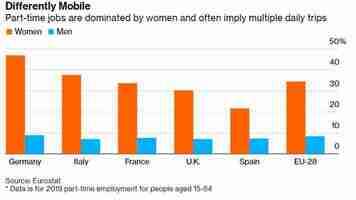Bon voyage! European cities bid adieu to sexist mobility policies
European cities are constantly making mobility greener, but there’s one issue they still haven’t tackled: making it gender-neutral.

Yup, gender can be a big factor in mobility. It’s been shown that women and men have very different travel needs and patterns , but this hasn’t really been considered in mobility plans of city governments — until now.
Cities in Europe now increasingly consider the gendered effects of transport policies and use them to inform adoption of less car-centric systems, Bloomberg reports.
Studies show that while men mostly do a single back-and-forth trip to work by car, women are more likely to make multiple trips per day. This is partly explained by women being forced to combine various activities with work, such as childcare and household chores — which often requires more traveling.


But the fact that women are more likely to take ‘more trips’ during the day doesn’t explain on its own why less car-centric policies are a more balanced approach in terms of gender. Not only do women move more frequently, they also do it mostly by public transport or walking, as you can see from the graph below.
This underlines two major needs for female commuters: the reduction of urban congestion that threatens the safety of pedestrians, and the accessibility to mass transit alternatives.
To address these issues, Paris introduced last year its plan to become a “ 15-minute city .” The idea is that residents access all essential services within 15 minutes of their home by foot, bike, or public transport — which in turn will improve gender equality .
In a similar vein, Barcelona has launched its “ superblocks ” scheme to direct traffic to the outskirts of each city block, and Austria is implementing the “ 1-2-3 Climate Ticket ” this year which gives access to its public transport nationwide for a flat a $3.6 per day, paid annually.
There are also stirrings in Germany, as center-left parties in Munich have pushed for city-planning based on gender equality .
It goes without saying that these initiatives represent only minor steps towards a gender-equal mobility model. But reducing urban traffic and enhancing safety and accessibility are definitely a step in the right direction which will benefit everyone.
Do EVs excite your electrons? Do ebikes get your wheels spinning? Do self-driving cars get you all charged up?
Then you need the weekly SHIFT newsletter in your life. Click here to sign up .
Artist imagines an electric Bugatti Type Atlantic 57 SC and it’s… iconic
The iconic Type Atlantic 57 SC coupe, produced between 1934 and 1940, is admittedly a piece of Bugatti legend . It’s elegant, sporty, luxurious, and rare, with only three cars still in existence.

Credit: Habib Orhan
Almost 100 years later, designer Habib Orhan has introduced his Bugatti Hommage 100 2036 concept car that reimagines the emblematic coupe as a futuristic electric-powered model.
Its spaceship-like shape is redefined in a more three-dimensional way, inspired by the Atlantic 57 SC and the C shape of the Ventoux coupe. The concept car also maintains the proportions of the GT series, to combine a luxurious and emotional touch with a modern sporty look.
Credit: Habib Orhan
Habib imagines his car in 2036, when the technological developments will allow for a chassis constructed from batteries and carbon fiber. At the same time, the wheels will house an engine which will presumably be powered by electricity as well.
Credit: Habib Orhan
Bugatti Hommage 100 2036’s tail design pays homage to the Atlantic with a riveted middle to make the car lighter. It also features lights to emphasize the vertical line separation.
Credit: Habib Orhan
Personally, I think that Habib’s design seems indeed like a brilliant remake of the legendary car. And it looks a bit like the 1989 Batmobile, which for me is an extra plus!
Credit: idealclassiccaret
If you’d like to know more about the project, you can visit Habib’s profile on behanceet .
HT – Yanko Design
Do EVs excite your electrons? Do ebikes get your wheels spinning? Do self-driving cars get you all charged up?
Then you need the weekly SHIFT newsletter in your life. Click here to sign up .
Stop hyping batteries, it’s pumped hydro that will save the planet
To cut U.S. greenhouse gas emissions in half within a decade , the Biden administration’s goal, the U.S. is going to need a lot more solar and wind power generation, and lots of cheap energy storage.

Wind and solar power vary over the course of a day, so energy storage is essential to provide a continuous flow of electricity. But today’s batteries are typically quite small and store enough energy for only a few hours of electricity. To rely more on wind and solar power, the U.S. will need more overnight and longer-term storage as well.
While battery innovations get a lot of attention , there’s a simple, proven long-term storage technique that’s been used in the U.S. since the 1920s.
It’s called pumped hydro energy storage . It involves pumping water uphill from one reservoir to another at a higher elevation for storage, then, when power is needed, releasing the water to flow downhill through turbines, generating electricity on its way to the lower reservoir.
Two types of pumped-storage hydropower; one doesn’t require a river (Credit: NREL )
Pumped hydro storage is often overlooked in the U.S. because of concern about hydropower’s impact on rivers. But what many people don’t realize is that most of the best hydro storage sites aren’t on rivers at all.
We created a world atlas of potential sites for closed-looped pumped hydro – systems that don’t include a river – and found 35,000 paired sites in the U.S. with good potential. While many of these sites, which we located by satellite, are in rugged terrain and may be unsuitable for geological, hydrological, economic, environmental or social reasons, we estimate that only a few hundred sites are needed to support a 100% renewable U.S. electricity system .
Why wind and solar need long-term storage
To function properly, power grids must be able to match the incoming electricity supply to electricity demand in real time or they risk shortages or overloads.
There are several techniques that grid managers can use to keep that balance with variable sources like wind and solar. These include sharing power across large regions via interstate high-voltage transmission lines, managing demand – and using energy storage.
The Kidston pumped hydro project in Australia uses an old gold mine for reservoirs (Credit: Genex Power )
Batteries deployed in homes, power stations and electric vehicles are preferred for energy storage times up to a few hours. They’re adept at managing the rise of solar power midday when the sun is overhead and releasing it when power demand peaks in the evenings.
Pumped hydro, on the other hand, allows for larger and longer storage than batteries, and that is essential in a wind- and solar-dominated electricity system. It is also cheaper for overnight and longer-term storage.
Off-river pumped hydro energy storage
In 2021, the U.S. had 43 operating pumped hydro plants with a total generating capacity of about 22 gigawatts and an energy storage capacity of 553 gigawatt-hours. They make up 93% of utility-scale storage in the country. Globally, pumped hydro’s share of energy storage is even higher – about 99% of energy storage volume .
Pump hydro projects can be controversial , particularly when they involve dams on rivers that flood land to create new reservoirs and can affect ecosystems.
Creating closed-loop systems that use pairs of existing lakes or reservoirs instead of rivers would avoid the need for new dams. A project planned in Bell County, Kentucky, for example, uses an old coal strip mine . Little additional land is needed except for transmission lines .
Examples from the atlas of off-river reservoirs with the potential to be paired for pumped hydro near Castle Rock, Colorado (Credit: Andrew Blakers , CC BY)
An off-river pumped hydro system comprises a pair of reservoirs spaced several miles apart with an altitude difference of 200-800 meters (about 650-2,600 feet) and connected with pipes or tunnels. The reservoirs can be new or use old mining sites or existing lakes or reservoirs .
On sunny or windy days, water is pumped to the upper reservoir. At night, the water flows back down through the turbines to recover the stored energy.
A pair of 250-acre reservoirs with an altitude difference of 600 meters (1,969 feet) and 20-meter depth (65 feet) can store 24 gigawatt-hours of energy, meaning the system could supply 1 gigawatt of power for 24 hours, enough for a city of a million people .
The water can cycle between upper and lower reservoirs for a hundred years or more. Evaporation suppressors – small objects floating on the water to trap humid air – can help reduce water evaporation. In all, the amount of water needed to support a 100% renewable electricity system is about 3 liters per person per day , equivalent to 20 seconds of a morning shower. This is one-tenth of the water evaporated per person per day in the cooling systems of U.S. fossil fuel power stations.
Storage to support 100% renewables
Little pumped storage has been built in the U.S. in recent years because there hasn’t been much need, but that’s changing.
In 2020, about three-quarters of all new power capacity built was either solar photovoltaics or wind power. Their costs have been falling, making them cheaper to build in many areas than fossil fuels.
Australia is installing solar and wind three times faster per capita than the U.S. and is already facing the need for mass storage . It has two systems under construction that are designed to have more energy storage than all the utility batteries in the world put together; another dozen are under serious consideration. None involve new dams on rivers. The annual operating cost is low, and the working fluid is water rather than battery chemicals.
Shifting electricity to renewable energy and then electrifying vehicles and heating can eliminate most human-caused greenhouse gas emissions. The U.S. has vast potential for off-river pumped hydro storage to help this happen, and it will need it as wind and solar power expand.